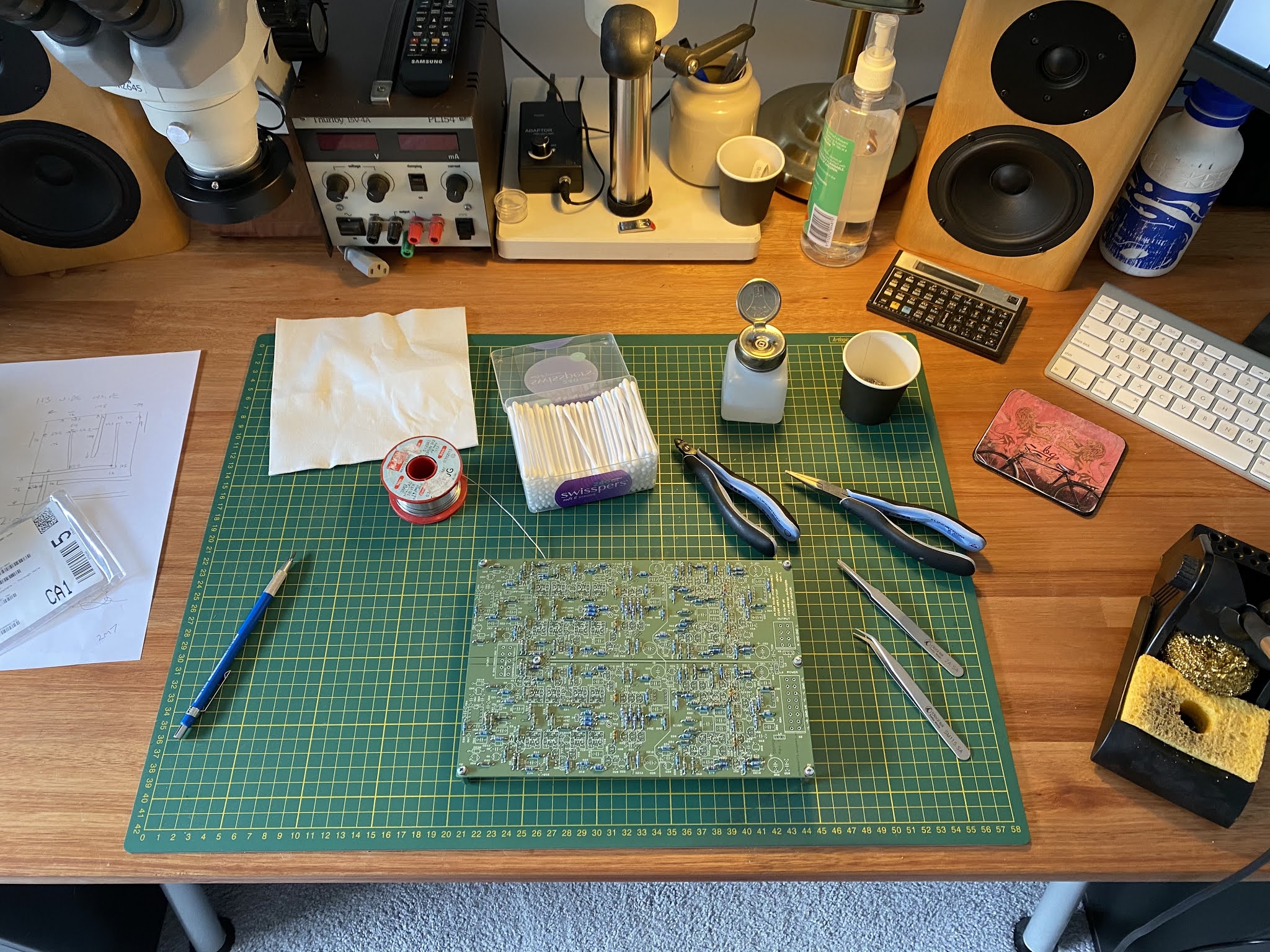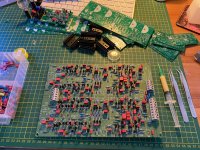Hi!
Has anyone of you checked my phono amp which is quite good, built with simple and cheap components.
QSXM2 extreme phono amp
Has anyone of you checked my phono amp which is quite good, built with simple and cheap components.
QSXM2 extreme phono amp
Hi Per,
specs are very good but I just kept thinking of all the holes I must drill when making this pcb😀
william
specs are very good but I just kept thinking of all the holes I must drill when making this pcb😀
william
Mr. Nelson like monster design?
Hi!
Mr Nelson Pass, weren't you the minimalistic guy? Do you like monster designs like mine?
Anyway, I like to do good designs, not necessarily simple ones but I appreciate simple designs if they also are high performing.
Hi!
Mr Nelson Pass, weren't you the minimalistic guy? Do you like monster designs like mine?
Anyway, I like to do good designs, not necessarily simple ones but I appreciate simple designs if they also are high performing.
Hi PerAnders,
I find RIAA´s with active correction of the 75 us time constant worse than those with passive correction. The treble becomes more harsh and it is harder to hear differences between instruments that generate high amounts of treble overtones.
Have you evaluated passive vs active correction ?
Kind regards
Syl
I find RIAA´s with active correction of the 75 us time constant worse than those with passive correction. The treble becomes more harsh and it is harder to hear differences between instruments that generate high amounts of treble overtones.
Have you evaluated passive vs active correction ?
Kind regards
Syl
Current capability
I think major drawback in RIAA amps are inferior current capability for the RIAA network. Have you tested your ideas with a powerful output stage?
You should listen to my "monster" amp. I'm personally amazed over the very detailed treble, especially with my simple gear. Ortofon FF15, the cheapiest needle from Ortofon.
Answer to your question: No, I haven't compared passive vs active correction (yet).
I think major drawback in RIAA amps are inferior current capability for the RIAA network. Have you tested your ideas with a powerful output stage?
You should listen to my "monster" amp. I'm personally amazed over the very detailed treble, especially with my simple gear. Ortofon FF15, the cheapiest needle from Ortofon.
Answer to your question: No, I haven't compared passive vs active correction (yet).
Hi PerAnders,
Yes, I have (fairly) powerful output stages. I use a 2-stage RIIA. The first is a linear stage set at 22 dB gain. The output drives the passive 75 us time constant (output impedance included in the calculations). The second stage (actively) corrects the bass range and provides a further 14 dB of gain. Both stages have an output quiescent current of 7 mA.
Parts count is minimal with a TOTAL of 6 transistors in the signal path, but still both stages have a differential input stage. I should say that transistors are critical for this RIIA to perform. Highly linear audio types is a must.
You know, to my ears, high detail is not necessarily the same thing as lack of harshness. Harshness to me is the inability of an amp to stop ringing after a high energy transient is induced in the circuitry. Some people find that sound appealing because "they can hear the bells ringing longer, so the sound must therefore be better". To me this is nothing but fatiguing distortion.
I have tried active and passive correction, and the passive correction wins hands down. More relaxed and less ringing, making it easier to hear the character of individual brands of hi-hats. Go that path and you will never go back...
Nice homepage BTW, I wish I had the time to do a page of my own.
Kind regards
Syl
Yes, I have (fairly) powerful output stages. I use a 2-stage RIIA. The first is a linear stage set at 22 dB gain. The output drives the passive 75 us time constant (output impedance included in the calculations). The second stage (actively) corrects the bass range and provides a further 14 dB of gain. Both stages have an output quiescent current of 7 mA.
Parts count is minimal with a TOTAL of 6 transistors in the signal path, but still both stages have a differential input stage. I should say that transistors are critical for this RIIA to perform. Highly linear audio types is a must.
You know, to my ears, high detail is not necessarily the same thing as lack of harshness. Harshness to me is the inability of an amp to stop ringing after a high energy transient is induced in the circuitry. Some people find that sound appealing because "they can hear the bells ringing longer, so the sound must therefore be better". To me this is nothing but fatiguing distortion.
I have tried active and passive correction, and the passive correction wins hands down. More relaxed and less ringing, making it easier to hear the character of individual brands of hi-hats. Go that path and you will never go back...
Nice homepage BTW, I wish I had the time to do a page of my own.
Kind regards
Syl
I have very little (none in fact) problems with "ringing". The step repsonse is excellent, even with the RIAA-net.
Once again, it was fun to design the amp. I never (almost) listen to old vinyl.
Once again, it was fun to design the amp. I never (almost) listen to old vinyl.
A step response gives no indication how the amp sounds when processing a hi-hat. I did not think of step response ringing when discussing that topic. But since neither of us listed to vinyl nowadays it does not really matter.
Looks impressive with all the components though. I´m not so fond of cascodes but that´s another story.
Kind regards
Syl
Looks impressive with all the components though. I´m not so fond of cascodes but that´s another story.
Kind regards
Syl
Can you explain how you detect "ringing" and what this phenomina really is?
I know that certain sounds are very sensitive, cymbals, flute, piano and so on.
Why don't you like cascodes? The only disadvantage is a slightly reduced output voltage swing. The big advantage is lower distortion, 5-10 times speed improvement, possible to create a "super transistor", fast, low noise, high voltage and high power.
I know that certain sounds are very sensitive, cymbals, flute, piano and so on.
Why don't you like cascodes? The only disadvantage is a slightly reduced output voltage swing. The big advantage is lower distortion, 5-10 times speed improvement, possible to create a "super transistor", fast, low noise, high voltage and high power.
Hi Pers
Very interesting design. Can I leave out the input servo portion altogether? MAX 420 is not available in India, is there a more common equivalent to this IC?
Very interesting design. Can I leave out the input servo portion altogether? MAX 420 is not available in India, is there a more common equivalent to this IC?
Omit it.
Hi!
You can omit the servo but you can also replace the opamp with a potentiometer but don't forget to smooth the voltage very carefully. Noise is directly injected so the current have to be "quite". For effective filtering place the enlarge the C63. 100µF/6-16V at least parallel with the original or some thing between 10n-100nF.
Hi!
You can omit the servo but you can also replace the opamp with a potentiometer but don't forget to smooth the voltage very carefully. Noise is directly injected so the current have to be "quite". For effective filtering place the enlarge the C63. 100µF/6-16V at least parallel with the original or some thing between 10n-100nF.
what's wrong with cascodes?
just wondering what your opinion on cascodes is. i have no first-hand experience with them but my professor in analog design class (worked at Analog Devices) seemed to swear by them. i will have to go look up my circuit book to remember how they work exactly...
cheers,
marc
just wondering what your opinion on cascodes is. i have no first-hand experience with them but my professor in analog design class (worked at Analog Devices) seemed to swear by them. i will have to go look up my circuit book to remember how they work exactly...
cheers,
marc
Cascodes
What is the advantage?
Picture this: 150-200 volts of voltage swing, High current gain, low noise, low capacitance base-collector. Can you find a transistor that will do this?
Cascodes are very useful in power amps.
What is the advantage?
Picture this: 150-200 volts of voltage swing, High current gain, low noise, low capacitance base-collector. Can you find a transistor that will do this?
Cascodes are very useful in power amps.
Marc,
Mr.Nelson Pass ( Notice the capitals 😀 ) has a good article on cascode amplifier design on his web site. The only place they don't seem to work is in amplifier output stages.
Regards,
Jam
Mr.Nelson Pass ( Notice the capitals 😀 ) has a good article on cascode amplifier design on his web site. The only place they don't seem to work is in amplifier output stages.
Regards,
Jam
Cascodes are only useful if the signal is taken out through the collector. If you had som wierd idea about "collector out" output stage if will work. I have seen a class A amp (Hiraga?) with "collector out" and therefore rather high output impedance (despite the feedback).
It begins!

It’s a lovely board. I like the use of E12 resistors exclusively. It means I didn’t have to order any in. The caps, are beyond my meager stocks of Wima film caps, and there’s no way I have enough BC550/560’s, so an order to Mouser is going out.

It’s a lovely board. I like the use of E12 resistors exclusively. It means I didn’t have to order any in. The caps, are beyond my meager stocks of Wima film caps, and there’s no way I have enough BC550/560’s, so an order to Mouser is going out.
- Home
- Amplifiers
- Solid State
- Monster overkill phono amp
